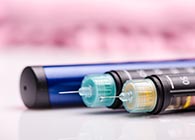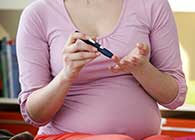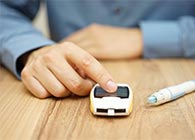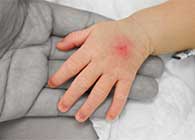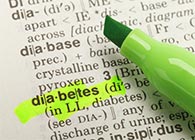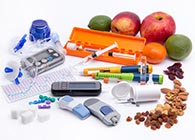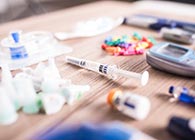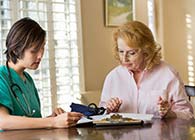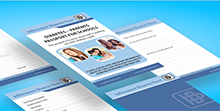Holidays and Travel Tips
Whether going on holiday abroad or in this country, it may be the first time you have travelled since your diabetes or your child’s diabetes was diagnosed. We hope that this information will give you a few practical tips and help you to plan ahead for your holiday. There is one thing to remember – anticipation of holidays and the day of travel causes excitement, especially in children.
General Tips
- Excitement can affect blood glucose levels, so it is important to test regularly and be prepared for some low blood glucose levels.
- Hypos may be unexpected due to changes in routine, in temperatures or in the amount of exercise taken, such as swimming or sightseeing, so always be prepared. It is a good idea to take plenty of glucose tablets with you because they won’t melt, leak or become sticky in high temperatures.
- When travelling always wear identification that states you have diabetes, especially if you take insulin, and if possible, gives an emergency telephone number.
Precautions when travelling by air
Insulin should not be packed in your suitcase. This will be placed in the hold where the temperature can be below freezing and this is likely to damage your insulin. Your blood glucose meter should also not be packed in the hold.
- Carry two lots of insulin, testing equipment and syringes/pens and distribute them between two different lots of hand luggage. If you use an insulin pump, always take spares and a syringe in case of pump failure. Luggage does get lost and it could prove difficult to replace your diabetes equipment.
- You should always carry a card to say that you or your child has diabetes. You will need a letter from your GP to explain that you have to carry insulin and other diabetes equipment on board with you. Once you have this letter, it can be used again for future trips. It is a good idea to make several copies of this letter.
- Always take more insulin than you need in case of breakages. The country that you are travelling to may not have the type of insulin you need. It is also a good idea to take an extra prescription with you, just in case.
- When you come home it is sensible to throw away the insulin you took on holiday as heat, bright light and vibration can all damage it and make it less effective.
- It is worth remembering that ordering a ‘diabetic’ meal on flights often means that they are low in carbohydrates, so it is probably not a good idea. On long journeys it is a good idea to have snacks to hand in case there are long periods without meals.
Precautions for pump users
Flying – cabin pressure can affect insulin delivery
Researchers in Australia have reported that changes in cabin pressure during flights may cause insulin pumps to deliver too much or too little insulin which could possibly put sensitive diabetes patients at risk. Those who are very sensitive to small changes in insulin dose are the ones who are going to be most sensitive to this – children and adults on small doses. The researchers recommend disconnecting the pump before take off and after landing and making sure there are no air bubbles in the insulin before reconnecting it. However, other researchers say that this does not seem to be a frequent and recurring problem.
After learning about a 10 year old girl with Type 1 diabetes whose blood sugar dropped about an hour after take off, the researchers found cases of other pump users with the same problem during flights. They put 10 pumps on a commercial flight and found that during take off, when the air pressure is decreasing, the pumps delivered about 1 to 1.4 extra units of insulin. During the descent, when pressure was increasing, about 1 unit of insulin was sucked back into the pumps causing them to give out too little insulin.
To prevent dangers when flying, they recommend the following:
- Cartridges should only contain 1.5 ml of insulin.
- The pump should be disconnected before take off, then remove air bubbles and reconnect while cruising.
- Disconnect again before landing and prime the line with 2 units of insulin after landing before reconnecting permanently.
- The pump should also be disconnected during flight emergencies when there is a big drop in cabin pressure.
It is possible that other big changes in pressure could cause pumps to deliver too much or too little insulin, such as ski-lifts.
Time zones
Generally short-haul flights require little or no adjustment and insulin injections can be carried out as normal. It is advisable to wait until the meal has arrived before injecting to avoid hypoglycaemia.
Longer journeys that cross time zones are more complicated and it is a good idea to discuss this with your diabetes nurse beforehand. Westbound journeys extend the day and extra insulin may be needed. Multi-dose regimes make this easier because Rapid-acting insulin can be given every 3 to 4 hours as needed. Eastbound journeys shorten the day and so the time between injections. It may be necessary to reduce the dose of long-acting or pre-mixed insulin. It can be helpful to keep your watch on ‘home’ time to keep track of your insulin doses.
Beating jetlag
Travelling across several time zones will probably cause some degree of jet lag. Symptoms include daytime sleepiness, fatigue, disorientation, poor concentration, headache and irritability. There are a number of ways to relieve jetlag:
- Avoid caffeine and alcohol on the plane – drink plenty of water or fruit juice.
- Eat modestly at times that correspond to the usual mealtimes as this will help your body to readjust to the new time zone.
- After a westward flight, stay awake while there is daylight and try to sleep when it is dark.
- After an eastward flight, get up in the morning but avoid bright light and go outdoors in the afternoon.
- Take moderate exercise, perhaps by sightseeing.
Holiday Insurance
If you or your child has diabetes, travel agents are not the best people to provide holiday insurance. It is better to shop around for insurance but you should always declare your diabetes and any other medical conditions, otherwise you may not be covered if anything goes wrong and you need to use the insurance.
If you are going on holiday in Europe you can use your European Health Insurance Card (EHIC) as long as it is valid. The UK issued EHICs for about 5 years and once it is about to expire, as a result of Brexit, you will have to apply for a Global Health Insurance Card (GHIC).
You can apply online on the NHS website: www.gov.uk/global-health-insurance-card or by Tel: 0300 330 1350.
Tips from readers
We collect tips from our members to pass on.
Here’s a tip from a couple who regularly fly abroad to Italy and France and although the lady carries medical equipment relating to her diabetes, her husband has a medical condition that requires him to carry equipment that includes a small pair of scissors. As advised he carries a letter from his GP, as should anybody carrying insulin pens, syringes blood testing equipment and any sharps. This had proved to be fine when flying into major airports. However, when they flew into a more provincial airport where the customs officers did not understand the letter as they could not read English, this resulted in an unpleasant and unnecessary search both his body and luggage. On their return home, they were talking to their son about the experience and he advised that they use Google Translator (http://translate.google.co.uk/?hl=en&tab=wT ) to get French and Italian versions of the letter. Since then they have flown to several provincial airports and have had no further problems. So, if you are travelling abroad and taking diabetes supplies with you, then get the letter you have from your GP translated into the relevant language to avoid any potential problems.
Another of our members regularly flies to Thailand and he advises notifying airports in advance that you will be carrying medication and sharps. His second piece of advice applies to anyone travelling to hot countries to purchase a digital thermometer that not only tells you the current temperature but also records the highest and lowest temperatures. This can then be placed in the fridge alongside supplies of insulin and used to adjust the temperature of the fridge to ensure it is running at the optimum temperature for storing insulin.
The Golden Rules – with or without diabetes
- Obtain comprehensive travel insurance, and read the small print.
- Research your destination – know the local laws and customs.
- Tell someone where you are going and leave them emergency contact details.
- Take enough money and have access to emergency supplies.
Useful Resources
The Foreign and Commonwealth Office: www.fco.gov.uk Tel 020 7088 1500. This office can help Britons abroad through its embassies, high commissions and consulates. Consular assistance is available in various circumstances such as hospitalisation or when some serious crimes against British people have been committed.
Global Health Insurance Card (GHIC) www.gov.uk/global-health-insurance-card Tel 0300 330 1350
National Travel Health Network and Centre: www.nathnac.org
Temperatures and insulin
Heat
Heat increases the circulation in the skin and increases the absorption of insulin when it is injected. Research has shown that at room temperature of 30°C, injected insulin was absorbed was three to five times greater than at 10°C which lowers blood glucose levels.
This lowering of blood sugars increases the risk of hypos and both heat and hypoglycaemia cause sweating and lethargy which can lead to delayed recognition of hypos. Therefore, it is important to blood glucose test more in hot weather.
Cold
Cold slows down the absorption of insulin. If there has been an accidental insulin overdose, applying a cold pack to the injection site delays the hypoglycaemic effect. However, when the site warms up, the insulin will be absorbed which risks hypoglycaemia sometimes hours later. (Practical Diabetes Vol 32, No 7)
Frequency of severe hypoglycaemia reduced in milder climates
Research has shown that people with diabetes experience more incidents of severe hypoglycaemia during hotter and colder weather. 2,500 people living in Hamburg were involved in the research which showed that severe hypos increased by 18% in higher temperatures and 15% in colder climates when compared with what the researchers describe as ‘the thermal comfort zone’ of temperatures between 10 and 20 degrees C.
The other interpretation of these findings is that severe hypoglycaemia is reduced in milder climates.
Only 8% of hypoglycaemic episodes took place outside, but when the researchers specifically looked at severe hypos that happened outside, the rate jumped to 21% in higher temperatures and 13% in cooler conditions.
The researchers say these findings could be clinically relevant but the underlying mechanisms for this are unknown. (Journal of Diabetes and its Complications, Feb 2017)
Keep your insulin cool
There are different methods and carrying cases for keeping insulin and insulin pens cool.
FRIO Wallets
FRIO wallets are designed to keep your insulin cool and safe for a minimum of 45 hours, even if the temperature is over 100 degrees Fahrenheit. The main advantages are that there are no bulky ice packs, you do not have to worry about finding a freezer to get supplies of ice and the wallet is light to carry.
It is activated by immersing it in cold water for 5-15 minutes. The panels of the wallet contain crystals and these expand into gel with the immersion in water. The system relies on the evaporation process for cooling. Vials and pens can be put into plastic bags to keep them dry without affecting the cooling properties of the wallets but FRIO also supply a zip stop water proof liner at an extra cost. ONLY the vials should be put in the plastic bag and NOT the whole pouch
For further details or to order a FRIO wallet the manufacturers can be contacted at: FRIO UK, PO Box 10, Haverfordwest SA62 5YG
Telephone 01437 741700 or e-mail info@friouk.com visit: www.friouk.com
Medicool Diabetes Insulin Cool Bags
You can buy online by visiting www.ninelife.uk or telephone +44 1615 195999
Kitbags to keep diabetes equipment in one place
Desang kitbags can keep all the tools for managing diabetes (blood testing kit, sugar supply and insulin as well as space for personal notes) in one place. They vary in price according to whether you chose a PVC one or a luxury leather one.
You can buy on-line by visiting www.desang.net
Diabetic holiday foot syndrome
Research has shown that there is a greater risk of foot ulceration that can lead to serious complications during holidays, especially those taken in hot countries, hence the name ‘Diabetic holiday foot syndrome’. Among 435 people studied, 17 experienced foot lesions during foreign holidays, 10 of whom reported a foot lesion for the first time. The people with holiday foot damage were a younger age, mainly male and their diabetes was of shorter duration.
The causes of diabetic holiday foot syndrome were:
- direct injury
- unaccustomed exercise
- walking barefoot on the beach or in the sea
- burns from walking barefoot on hot pavements
- wearing inappropriate inflexible bathing shoes.
If you need further warnings for your holidays, the research also showed that nine out of the 17 people had to be hospitalised for infections as a result of the foot damage and the average stay in hospital was 11 days.
The researchers conclude that there is a need to increase education about foot care at holiday periods and that this should include preventative measures for those people at high risk of foot lesions.
Just a warning – weight increase while on holiday!
A study in the general population in the American journal, Physiology & Behavior, showed that 61% of US adults gained weight while on holiday, ranging from an average of 0.7 pounds to as much as 7 pounds, which tended to stay on after returning home. The research involved 122 adults, ages 18 to 65 and found that holiday weight gain was caused by an increased intake of calories, especially from alcohol.
Simple steps to combat sunburn
The British Skin Foundation has issued advice on what to do if you do get sunburnt. Here they are:
- Keep the sunburnt area covered, stay in the shade until it has healed and wear cotton clothing.
- Over-the-counter analgesics or painkillers can relieve the pain and reduce any inflammation (if there are no contraindications).
- Cool the skin by applying a cool, compress for 15 minutes or by having a cool bath / shower. Do not rub your skin with a towel, just pat it dry.
- Reduce peeling by using un-perfumed cream or lotion after a bath or shower to soothe the skin and repeat this as necessary.
- Leave blisters alone, do not pop them as this can lead to infection and scarring.
- Rehydrate as sunburn can lead to fluid loss through the skin, so drink plenty of water and avoid alcohol.
Finally – coping with diabetes and the heat of summer
- Drink plenty of water as dehydration can raise blood glucose levels.
- Sunburn can raise blood glucose levels, so avoid spending long hours in the sun and wear sunscreen of at least 30 SPF and children or people with pale skin should use 50 SPF.
- Shield you meter from the sun and test strips should be kept in a cool, dry place.
- People who use a pump may need to protect the adhesive patch from perspiration by using an antiperspirant at the contact site.
- In very hot weather insulin is absorbed more quickly, so test regularly to avoid hypos.
Perhaps worth remembering…It is a holiday, so enjoy it!
© IDDT April 2023
If we can be of help in any way, please contact:
InDependent Diabetes Trust [IDDT]
PO Box 294, Northampton NN1 4XS
Tel 01604 622837 email enquiries@iddtinternational.org


